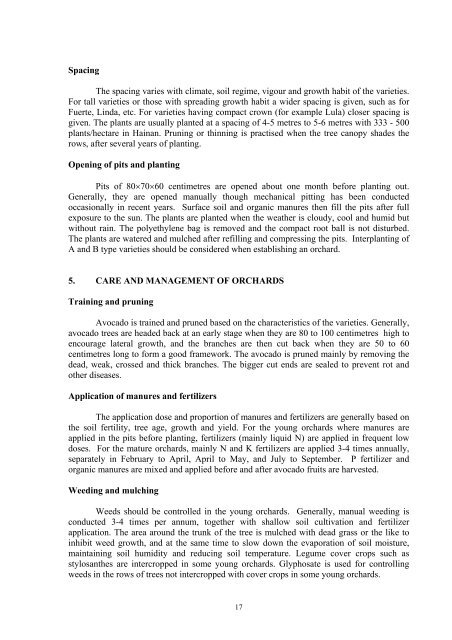Avocado Production in Asia and the Pacific - United Nations in ...
Avocado Production in Asia and the Pacific - United Nations in ...
Avocado Production in Asia and the Pacific - United Nations in ...
Create successful ePaper yourself
Turn your PDF publications into a flip-book with our unique Google optimized e-Paper software.
Spac<strong>in</strong>g<br />
The spac<strong>in</strong>g varies with climate, soil regime, vigour <strong>and</strong> growth habit of <strong>the</strong> varieties.<br />
For tall varieties or those with spread<strong>in</strong>g growth habit a wider spac<strong>in</strong>g is given, such as for<br />
Fuerte, L<strong>in</strong>da, etc. For varieties hav<strong>in</strong>g compact crown (for example Lula) closer spac<strong>in</strong>g is<br />
given. The plants are usually planted at a spac<strong>in</strong>g of 4-5 metres to 5-6 metres with 333 - 500<br />
plants/hectare <strong>in</strong> Ha<strong>in</strong>an. Prun<strong>in</strong>g or th<strong>in</strong>n<strong>in</strong>g is practised when <strong>the</strong> tree canopy shades <strong>the</strong><br />
rows, after several years of plant<strong>in</strong>g.<br />
Open<strong>in</strong>g of pits <strong>and</strong> plant<strong>in</strong>g<br />
Pits of 80×70×60 centimetres are opened about one month before plant<strong>in</strong>g out.<br />
Generally, <strong>the</strong>y are opened manually though mechanical pitt<strong>in</strong>g has been conducted<br />
occasionally <strong>in</strong> recent years. Surface soil <strong>and</strong> organic manures <strong>the</strong>n fill <strong>the</strong> pits after full<br />
exposure to <strong>the</strong> sun. The plants are planted when <strong>the</strong> wea<strong>the</strong>r is cloudy, cool <strong>and</strong> humid but<br />
without ra<strong>in</strong>. The polyethylene bag is removed <strong>and</strong> <strong>the</strong> compact root ball is not disturbed.<br />
The plants are watered <strong>and</strong> mulched after refill<strong>in</strong>g <strong>and</strong> compress<strong>in</strong>g <strong>the</strong> pits. Interplant<strong>in</strong>g of<br />
A <strong>and</strong> B type varieties should be considered when establish<strong>in</strong>g an orchard.<br />
5. CARE AND MANAGEMENT OF ORCHARDS<br />
Tra<strong>in</strong><strong>in</strong>g <strong>and</strong> prun<strong>in</strong>g<br />
<strong>Avocado</strong> is tra<strong>in</strong>ed <strong>and</strong> pruned based on <strong>the</strong> characteristics of <strong>the</strong> varieties. Generally,<br />
avocado trees are headed back at an early stage when <strong>the</strong>y are 80 to 100 centimetres high to<br />
encourage lateral growth, <strong>and</strong> <strong>the</strong> branches are <strong>the</strong>n cut back when <strong>the</strong>y are 50 to 60<br />
centimetres long to form a good framework. The avocado is pruned ma<strong>in</strong>ly by remov<strong>in</strong>g <strong>the</strong><br />
dead, weak, crossed <strong>and</strong> thick branches. The bigger cut ends are sealed to prevent rot <strong>and</strong><br />
o<strong>the</strong>r diseases.<br />
Application of manures <strong>and</strong> fertilizers<br />
The application dose <strong>and</strong> proportion of manures <strong>and</strong> fertilizers are generally based on<br />
<strong>the</strong> soil fertility, tree age, growth <strong>and</strong> yield. For <strong>the</strong> young orchards where manures are<br />
applied <strong>in</strong> <strong>the</strong> pits before plant<strong>in</strong>g, fertilizers (ma<strong>in</strong>ly liquid N) are applied <strong>in</strong> frequent low<br />
doses. For <strong>the</strong> mature orchards, ma<strong>in</strong>ly N <strong>and</strong> K fertilizers are applied 3-4 times annually,<br />
separately <strong>in</strong> February to April, April to May, <strong>and</strong> July to September. P fertilizer <strong>and</strong><br />
organic manures are mixed <strong>and</strong> applied before <strong>and</strong> after avocado fruits are harvested.<br />
Weed<strong>in</strong>g <strong>and</strong> mulch<strong>in</strong>g<br />
Weeds should be controlled <strong>in</strong> <strong>the</strong> young orchards. Generally, manual weed<strong>in</strong>g is<br />
conducted 3-4 times per annum, toge<strong>the</strong>r with shallow soil cultivation <strong>and</strong> fertilizer<br />
application. The area around <strong>the</strong> trunk of <strong>the</strong> tree is mulched with dead grass or <strong>the</strong> like to<br />
<strong>in</strong>hibit weed growth, <strong>and</strong> at <strong>the</strong> same time to slow down <strong>the</strong> evaporation of soil moisture,<br />
ma<strong>in</strong>ta<strong>in</strong><strong>in</strong>g soil humidity <strong>and</strong> reduc<strong>in</strong>g soil temperature. Legume cover crops such as<br />
stylosan<strong>the</strong>s are <strong>in</strong>tercropped <strong>in</strong> some young orchards. Glyphosate is used for controll<strong>in</strong>g<br />
weeds <strong>in</strong> <strong>the</strong> rows of trees not <strong>in</strong>tercropped with cover crops <strong>in</strong> some young orchards.<br />
17
















